市场资讯及洞察

Most traders understand EA portfolio balance through the lens of traditional risk management — controlling position sizes, diversifying currency pairs, or limiting exposure per trade.
But in automated trading, balance is about deliberately constructing a portfolio where different strategies complement each other, measuring their collective performance, and actively managing the mix based on those measurements.
The goal is to create a “book” of EAs that can help diversify performance over time, even when individual strategies hit rough patches.
A diversified mix of EAs across timeframes and assets can, in some cases, reduce reliance on any single strategy. This approach reduces dependency on any single EA’s performance, smooths your overall equity curve, and builds resilience across changing market conditions.
It’s about running the right mix, identifying gaps in your coverage, and viewing your automated trading operation as an integrated whole rather than a collection of independent systems.
Basic Evaluation Metrics – Your Start Point
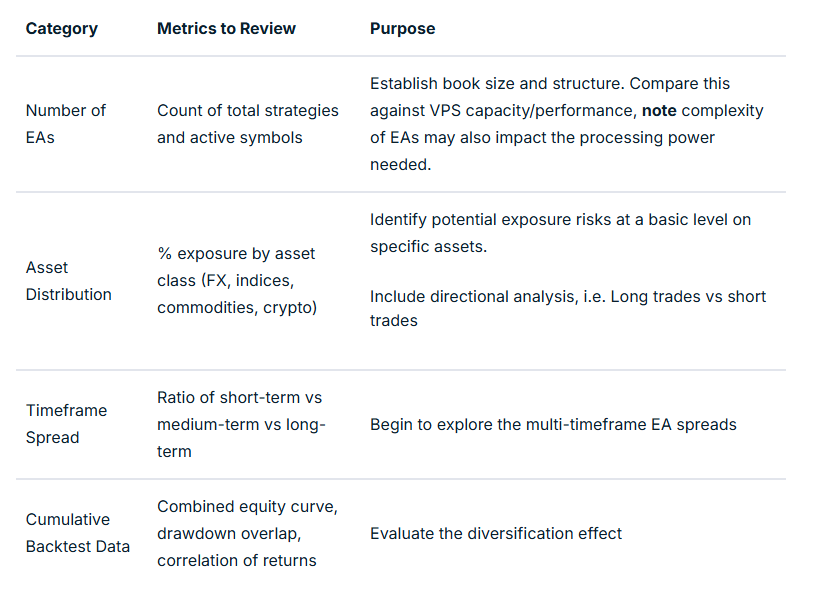
Temporal (timeframe) Balancing
When combined, a timeframe balance (even on the same model and instrument) can help flatten equity swings.
For example, a losing phase in a fast-acting M15 EA can often coincide with a profitable run in an H4 trend model.
Combining this with some market regime and sessional analysis can be beneficial.
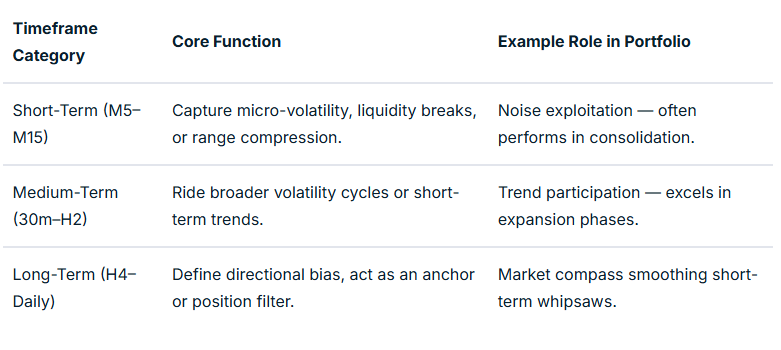
Asset Balance: Managing Systemic Correlation Risk
Running five different EAs on USDJPY might feel diversified if each uses different entry logic, even though they share the same systemic market driver.
But in an EA context, correlation measurement is not necessarily between prices, but between EA returns (equity changes) relating to specific strategies in specific market conditions.
Two EAs on the same symbol might use completely different logic and thus have near-zero correlation.
Conversely, two EAs on a different symbol may feel as though they should offer some balance, but if highly correlated in specific market conditions may not achieve your balancing aim.
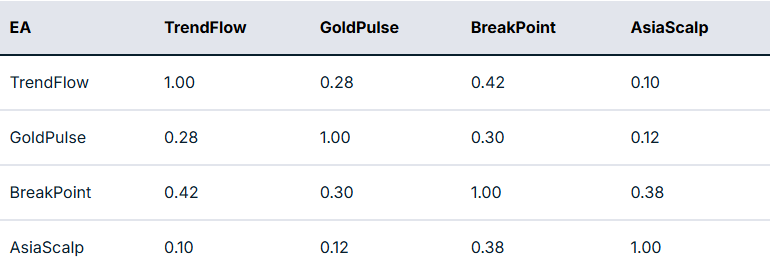
In practical terms, the next step is to take this measurement and map it to potential actionable interventions.
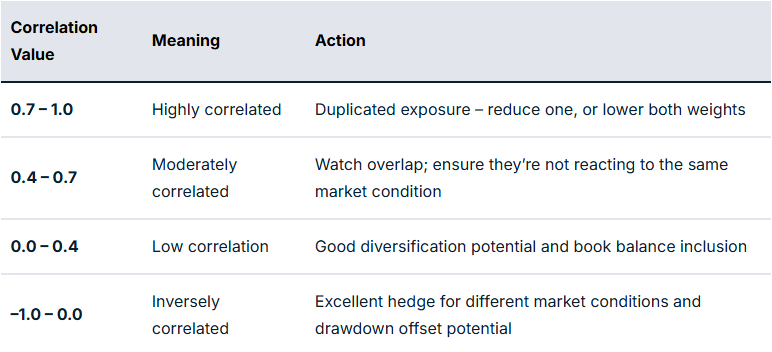
For example, if you have a EURUSD Trend EA and a GBPUSD Breakout EA with a correlation of 0.85, they are behaving like twins in performance related to specific market circumstances. And so you may want to limit exposure to some degree if you are finding that there are many relationships like this.
However, if your gold mean reversion EA correlates 0.25 compared to the rest of your book, this may offer some balance through reducing portfolio drawdown overlap.
Directional and Sentiment Balance
Markets are commonly described as risk-on or risk-off. This bias at any particular time is very likely to impact EA performance, dependent on how well balanced you are to deal with each scenario.
You may have heard the old market cliché of “up the staircase and down the elevator shaft” to describe how prices may move in alternative directions. It does appear that optimisation for each direction, rather than EAs that trade long and short, may offer better outcomes as two separate EAs rather than one catch-all.
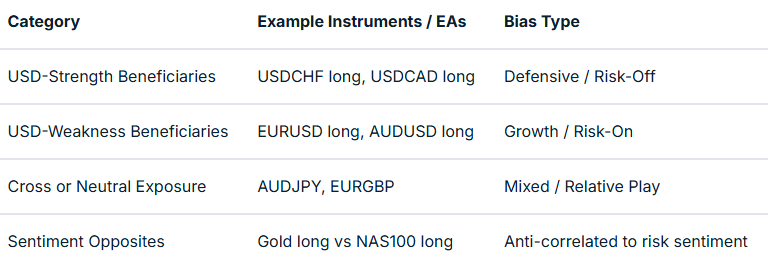
Market Regime and Volatility Balance
Trend and volatility states can have a profound impact on price action, whether as part of a discretionary or EA trading system. Much of this has a direct relationship to time of day, including the nature of individual sessions.
We have a market regime filter that incorporates trend and volatility factors in many EAs to account for this. This can be mapped and tested on a backtest and in a live environment to give evidence of strategy suitability for specific market conditions.
For example, mean reversion strategies may work well in the Asian session but less so in strongly trending markets and the higher volatility of the early part of the US session.
As part of balancing, you are asking questions as to whether you actually have EA strategies suited to different market regimes in place, or are you using these together to optimise book performance?
The table below summarises such an approach of regime vs market mapping:
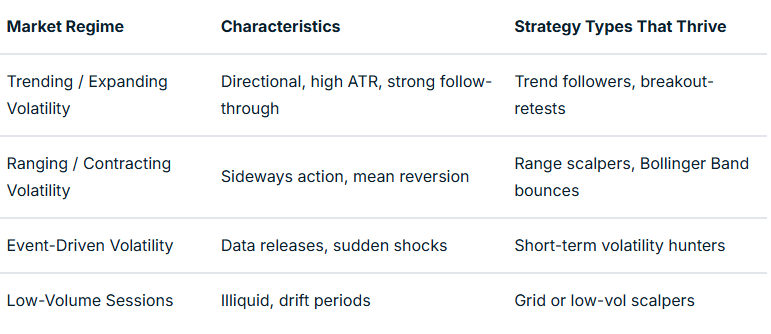
Multi-Level Analysis: From Composition to Interaction
Once your book is structured, the challenge is to turn it into something workable. An additional layer of refinement that turns theory and measurement into something meaningful in action is where any difference will be made.
This “closing the circle” is based on evidence and a true understanding of how your EAs are behaving together. It is the step that takes you to the point where automation can begin to move to the next level.
Mapping relationships with robust and detailed performance evaluation will take time to provide evidence that these are actually making a difference in meeting balancing aims.
To really excel, you should have systems in place that allow ongoing evaluation of the approaches you are using and advise of refinements that may improve things over time.
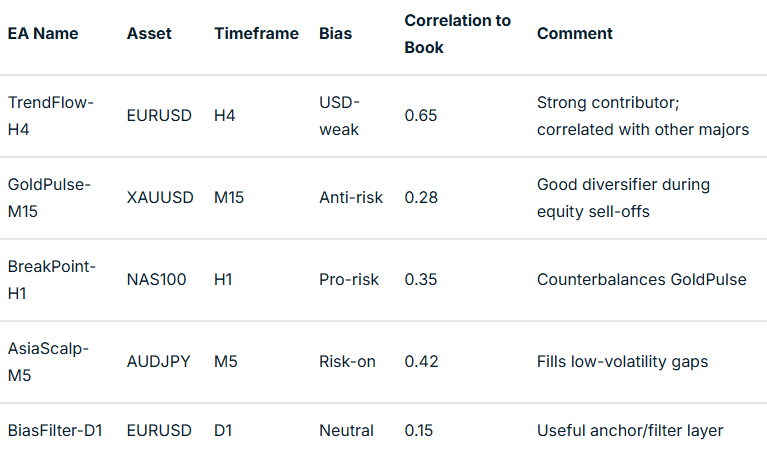
What Next? – Implementing Balance in Practice
Theory must ultimately translate into an executable EA book. A plan of action with landmarks to show progress and maintain motivation is crucial in this approach.
Defining classification tags, setting risk weights, and building monitoring dashboards are all worth consideration.
Advanced EA traders could also consider a supervisory ‘Sentinel’ EA, or ‘mothership’ approach, to enable or disable EAs dynamically based on underlying market metrics and external information integrated into EA coding decision-making.
Final Thoughts
A balanced EA portfolio is not generated by accident; it is well-thought-out, evidence-based and a continuously developing architecture. It is designed to offer improved risk management across your EA portfolio and improved trading outcomes.
Your process begins with mapping your existing strategies by number, asset, and timeframe, then expands into analysing correlations, directional bias, and volatility regimes.
When you reach the stage where one EA’s drawdown is another’s opportunity, you are no longer simply trading models but managing a system of EA systems. To finish, ask yourself the question, “Could this approach contribute to improved outcomes over time?”. If your answer is “yes,” then your mission is clear.
If you are interested in learning more about adding EAs to your trading toolbox, join the new GO EA Programme (coming soon) by contacting [email protected].


Every serious trader has “had a go” at scalping at some point in their journey. The idea of rapid and high-frequency entries, quick profits, with dozens of trades in a single session, suggests that it is a fast path to achieving a potential income from trading. The theory is that if you can make just a few pips or points repeatedly and frequently, the results should compound quickly and on a sustainable basis. However, stories of multiple account blow-ups and trader burnouts as the effort in a higher stress situation takes its toll bring up justifiable questions as to whether this “good on paper” theory can translate into real-world trading success.
What Is Scalping?
Scalping involves placing a high volume of very short-term trades, aiming to capture small price movements with trades that are opened and closed within minutes or even seconds of entry. Scalpers rely on precision in action, timing, and tight cost control, rather than letting trades breathe or evolve into longer moves, as you see in other types of trading approaches.Scalping is commonly used in markets with the highest liquidity, where the spread is at its tightest.For example:
- Forex majors (e.g., EUR/USD, GBP/USD)
- Index futures (e.g., NASDAQ, DAX, FTSE)
- Commodities like gold (though spread and volatility can be a challenge)
How Does Scalping Work?
Traders using a scalping approach are looking for small inefficiencies or bursts of movement they can exploit repeatedly as sentiment shifts.Three common types of scalping techniques include: momentum scalping, mean reversion, and order flow scalping. The first two of these can be used on CFDs on Metatrader platforms. The latter is more common in futures markets.
Momentum Scalping
This approach involves looking for and jumping on breakouts or price surges as price momentum begins to build, with an exit quickly before price begins to pause. This is most commonly used at session opens or news events when the volume of traders is high and repositioning of trader positions may be at its highest. Faster timeframes are usually used, e.g., 1-minute candles, when there appears to be a brief but technically identifiable sentiment change.
Range-Bound / Mean Reversion Scalping
Mean reversion strategies are based on the principle that prices regularly trade in a range, often while market participants are waiting for the next piece of news or technical breach of either the top or bottom of that range. During this time, as the range high and low are tested, it is common that the price will return to the mean of that range after each unsuccessful test. Scalpers will attempt to identify these micro-ranges and short a test to the upper end or go long with tests of the bottom end. This can work best in the quieter part of sessions or during consolidation periods, with a breach of the defined support/resistance used as a relatively obvious risk management level.
Key Principles of a Successful Scalping Strategy
Execution Speed
Fast and reliable execution is critical to optimise scalping strategies. Slippage, delayed fills, and lower liquidity with wider spreads can eat into profits significantly in these strategies, where the profit target is often just a few pips. Scalpers may use dedicated VPS servers where latency is less and, when there is evidence that a strategy may be working, may attempt to create EAs that execute the criteria for entry and exit automatically to maximise the time your strategy is working on the market (i.e. it is doing this even when you are not in front of a screen).
Low Spread and Commission
Spread becomes an essential component of your profit potential, more so than with any other strategy. If you are aiming for 3–5 pips of profit and the spread takes most of this away, your market battle becomes even harder than it already is. Even a small difference in transaction costs can erode a scalper’s profitability significantly over hundreds of trades. GO Markets offers very competitive spreads as well as other options for spread traders to help you find the best solution for you.
Clear, Repeatable Entry Rules
Because scalping relies on speed and repetition, there is no room for ambiguity or options in any part of your trading rules for action. Entry criteria must be specific, precise, and must be actioned without hesitation once the defined action price hits your trigger level. What you use as these action points is irrelevant in this context, be it candle closes or tick movement, the rules need to be black-and-white and actioned accordingly.
Tight Risk Control
Risk management is important in any trading context, and in scalping, this is no different. Stops can be just a few pips or points away, and a single large loss due to second-guessing or not following the plan can easily and quickly undo gains from several winning trades. Having referenced the absolute necessity for specific and unambiguous criteria for entry, this is no less vital for exit if you are to achieve your target win rate, desired average won-loss, and maximum acceptable drawdown.
Time-Bound Trading
Scalping strategies, by their nature, are usually mentally intense with concentration levels critical when trading. Management of this should be front and centre of your time plan when you are trading. You should set clear, pre-determined, and non-negotiable start and end times, limiting the amount of time to maintain an optimum trading state and reduce the likelihood of errors in decision making. For example, if your scalping plan is best actioned on session opens, limit your time to these, then walk away.
Risks and Pitfalls of Scalping
While scalping can be successful if you adopt the key principles above, it’s also very easy to fall short of what is required to achieve success on an ongoing basis. Rigidly adhering to what is needed is something to constantly remind yourself of, as there are common key challenges that have the ability to derail the trader (and they often do).
Overtrading
Scalping may lead to ‘compulsive’ overtrading. The “thrill of the chase” created by the high intensity of this trading style can tempt traders to push past their planned trade limits, stray from the strict criteria for entry, as they try to force more trades. These rarely create positive trading outcomes.
Spread and Slippage
You need to become a measurement guru, watching key trading metrics on an ongoing basis, including the impact of cost,s is critical as previously stated. Widening spreads can be massively impactful on profit potential, and some would have a maximum spread as part of the entry criteria because of this. This can and should be reviewed during your trading activity and as part of your trading business ritual.
Psychological Strain
Scalping is high-pressure and “fast” decision-making and action-taking. This pace is not for every trader, and you must monitor both your behaviour and performance during trading, adhering to and reviewing the boundaries you have set, but also be honest with yourself to look at something else if this is just simply not a “fit” for you.
The Case for Automation?
Many scalpers explore the use of EAs for the automation of their tested scalping strategies. Of course, this will eliminate some of the critical challenges by taking away the immediate “in front of chart” stress.There is also a strong case that this will help in “not missing” trades through an inability to watch markets for 24 hours.Don't be fooled, though; this is not a shortcut. The same rigour in terms of creation, testing, and ongoing monitoring with refinement remains. It is not saving work — as much work is still required if you are to achieve any success. It is using a tool to provide more execution certainty. It is perhaps worth considering once you have a strategy that shows promise and ticks all of the boxes for the scalping strategy criteria.
A Simple Momentum Scalping Strategy (Example)
Here is an example of a very basic framework for a 1-minute momentum scalping setup on EUR/USD. *Note: This is merely an example of how scalpers may structure a scalping plan:Market: EUR/USDTimeframe: 1 MinuteSession: First 60 minutes of London OpenSetup Logic:
- Identify when price breaks a 5-bar high with momentum
- Volume increase from previous bar
- Look for a strong bullish candle (body >70% of range)
- Ensure spread is below 0.4 pips
Entry:
- Buy at breakout +2 pips on 1 minute bar close
Exit:
- Use a hard stop of 2 pips from entry signal
- Target 6 pips profit
- Trail stops to breakeven on a 3 pip move
Risk Notes:
- No more than 6 trades in a session to maintain focus
- Cap trading session time to 60 minutes.
Final Thoughts
Despite the attractive and exciting high-intensity battle of trader versus market, scalping is not a shortcut or a casual strategy. It’s a high-performance, rigid approach that requires great preparation, clarity of planning and action, reaction speed, and precision in execution. Take a step-by-step approach; it may be for you (and don’t be shy of walking away if you discover it is not). You need to put in the “hard yards” at the front end if you want to see trading rewards from scalping.


本周全球金融市场迎来多重变量,投资者需密切关注宏观政策与资产轮动节奏。首先是贸易政策不确定性再度升温。美国方面持续推进调整关税结构,涉及多个经济体,谈判窗口期所剩不多,市场担忧短期内达成多边贸易协议的可能性较低。而支撑当前市场情绪的,仍是美方强力财政注资政策,为股市提供了充足流动性预期。与此同时,美联储的独立性议题成为市场热议焦点。近期有关管理层行为的讨论持续发酵,部分评论担心若高层职位发生变动,可能影响货币政策的连贯性,进而对市场稳定构成挑战。投资者密切关注即将发布的CPI数据,目前预测值高于前值,若数据证实通胀压力回升,将影响降息预期。在资产表现上,比特币于周末突破11.8万美元,数字货币板块成为近期市场亮点。本周被市场称为“数字货币周”,多项行业相关政策有望陆续落地。稳定币板块分化明显,CRCL波动加剧,而COIN与MSTR则表现强劲。

黄金价格因避险情绪升温而走强,美元指数早盘同步上涨,双双推升贵金属配置价值。尽管上周股指小幅回调,但整体分化格局明显,部分板块保持相对强势。其中,核技术板块迎来反弹,美铀价格止跌回升,利好今日澳洲相关资源股表现。AI领域方面,英伟达市值首次触及4万亿美元,公司执行层将亮相重要会议,引发市场高度关注。特斯拉方面,自动驾驶新进展叠加交付超预期,短期看涨情绪升温。汇市方面,风险事件可能对主要货币走势造成冲击。市场正高度关注美联储政策预期是否稳定,若有任何人事变动迹象,都将成为市场波动的重要催化剂。当前美元维持在7.17兑人民币的平台,澳元回升至4.71上方,日元早盘走强,整体汇市波动仍相对温和。联系方式:墨尔本 03 8658 0603悉尼 02 9188 0418中国地区(中文) 400 120 8537中国地区(英文) +248 4 671 903作者:Xavier Zhang | GO Markets 高级分析师


自从川普的关税暂缓开始,美股七巨头基本都收复了大部分失地,英伟达和微软甚至创出新高,只有特斯拉和苹果的表现令人十分无语。苹果是因为在AI的布局失误,错失了这波AI浪潮,它的一蹶不振可以说得过去,但可以称作未来AI应用最强公司的特斯拉,为什么没能一飞冲天呢?我们今天就来聊一聊这个“赛博”公司。特斯拉目前情况特斯拉的股价自2024年12月的历史高点479.86美元以来,股价已下跌约38% 。关税缓和后,从214回升到368,然而没能继续保持上升,在368和280之前疯狂波动,其中因素很多,我们一一来讲。首先特斯拉的老板马斯克,他是个远大目标的人,其不喜欢美政治家的虚伪,最开始希望通过火星移民计划建立世外桃源——后来发现远离解决不了问题,便支持川普以身入局——而后川普成功当选,他晋升“一字并肩王”主持政府效率部——再到打入冷宫——现在起身反抗成立“美国党”。马斯克这段起起伏伏的经历完全映射到了特斯拉的股价上,其政治立场引发的争议,确实影响了品牌的形象。但他对特斯拉有着久远的规划,而且正在一步一步的完成,具体我们后面讲,下面先讲一下特斯拉公司运营情况。一说起特斯拉,很多人的第一反应都是“全球电动汽车的龙头”,也确实电车业务是它目前的核心业务,占了总营收75%,同时它也有其他业务,这里我们以图表形式展示出来:

电车作为其核心业务,再把特斯拉的市场份额给大家呈现出来:

我们可以看出特斯拉电车的市场份额在逐渐下降,这是因为比亚迪等中国品牌在全球的份额持续增长,提供了更多样化和价格更具竞争力的车型 。竞争能力下降是股价表现不好的原因之一。但也不能仅凭当前核心业务在下行就否定特斯拉,况且他定位本身就不是汽车公司而是科技公司,前面说到马斯克对特斯拉有着长久的规划,特斯拉不会止步于此,它会是未来最强AI应用公司,下面且听我道来。为什么特斯拉可以被称为未来AI应用最强股首先大家有没有发现个很奇怪的现象,特斯拉车主有狂热的忠诚度,你问他们推荐什么电车,他们绝对会说特斯拉,甚至你不问都会给你推荐。拥有过特斯拉不像拥有了一辆车就像拥有了一个聪明的助手。特斯拉的自动驾驶技术完全自研,而且是基于视觉模型的自动驾驶。可能国内的朋友感受不到他的强大,因为这种自动驾驶需要现实路况记录进行训练,特斯拉很难获取国内的道路数据,所以体验不到它的满血版。自动驾驶FSD是AI最成熟的商业化场景之一,特斯拉已部署数百万辆车用于数据采集+训练闭环,每天海量数据可反哺AI模型,这是Waymo、百度Apollo等无法比拟的。可以理解为他在不停的进步,卖车的同时获得驾驶数据,反哺自动驾驶系统,这样会让他的自动驾驶系统越来越完美。并且凭借出色的自驾系统,特斯拉的无人驾驶出租车项目(Robotaxi)也已经在试运行,这也将是其未来的一大成长点。然后是马斯克的另一个布局——机器人。黄仁勋在最近一次的英伟达股东给大会上表示,人工智能和机器人技术有数万亿美元的市场机会。机器人的发展面临两个问题,一是视觉训练数据,二是储能问题。特斯拉毕竟在视觉训练已有起步,而且拥有自研芯片(Dojo),可以优化神经网络训练,摆脱对英伟达GPU的依赖,体现出其AI硬科技能力。特斯拉具备了机器人全产业链条整合能力,有AI算法,芯片,真实世界数据,能自主设计机器人,能通过自身供应链来制造Optimus机器人,从大脑到身体全部自己掌握,自己一个人就打通了整个产业链。这是特斯拉在机器人这个万亿市场的立足点。

特斯拉的叙事——科技公司不是汽车公司尽管特斯拉股价最近表现并不太好,但是之前购买特斯拉股票的小伙伴,不就是相信了特斯拉的故事吗?只要故事正在变成现实那就不要怕是“鬼故事”,坚定的相信就好。至于马斯克的政治立场,是可以短期波动特斯拉的股价,但影响不到特斯拉实打实的科技进步,也就影响不到特斯拉的根基。“最强的AI应用潜力股”,我们且看他的表现吧。免责声明:GO Markets 分析师或外部发言人提供的信息基于其独立分析或个人经验。所表达的观点或交易风格仅代表其个人;并不代表 GO Markets 的观点或立场。联系方式:墨尔本 03 8658 0603悉尼 02 9188 0418中国地区(中文) 400 120 8537中国地区(英文) +248 4 671 903作者:Mill Li | GO Markets 墨尔本中文部


Despite living through one of the most chaotic political and trade environments in recent history, the ASX 200 delivered its strongest performance since the pandemic rally.The S&P/ASX 200 Index gained 9.97% in capital growth and 13.81% in total returns, hitting a record high of 8,639.1 points in June.While Trump's tariff announcements caused dramatic market swings — including the ASX plunging nearly 500 points on "Liberation Day" — Australian markets weathered the storm and managed to rally before the financial year end.The rally was driven primarily by heavyweight banks like Commonwealth Bank and Westpac, with CBA alone responsible for nearly half the index's gains.However, the performance was not uniform across all sectors — five of the 11 ASX market sectors actually lost value during the financial year.
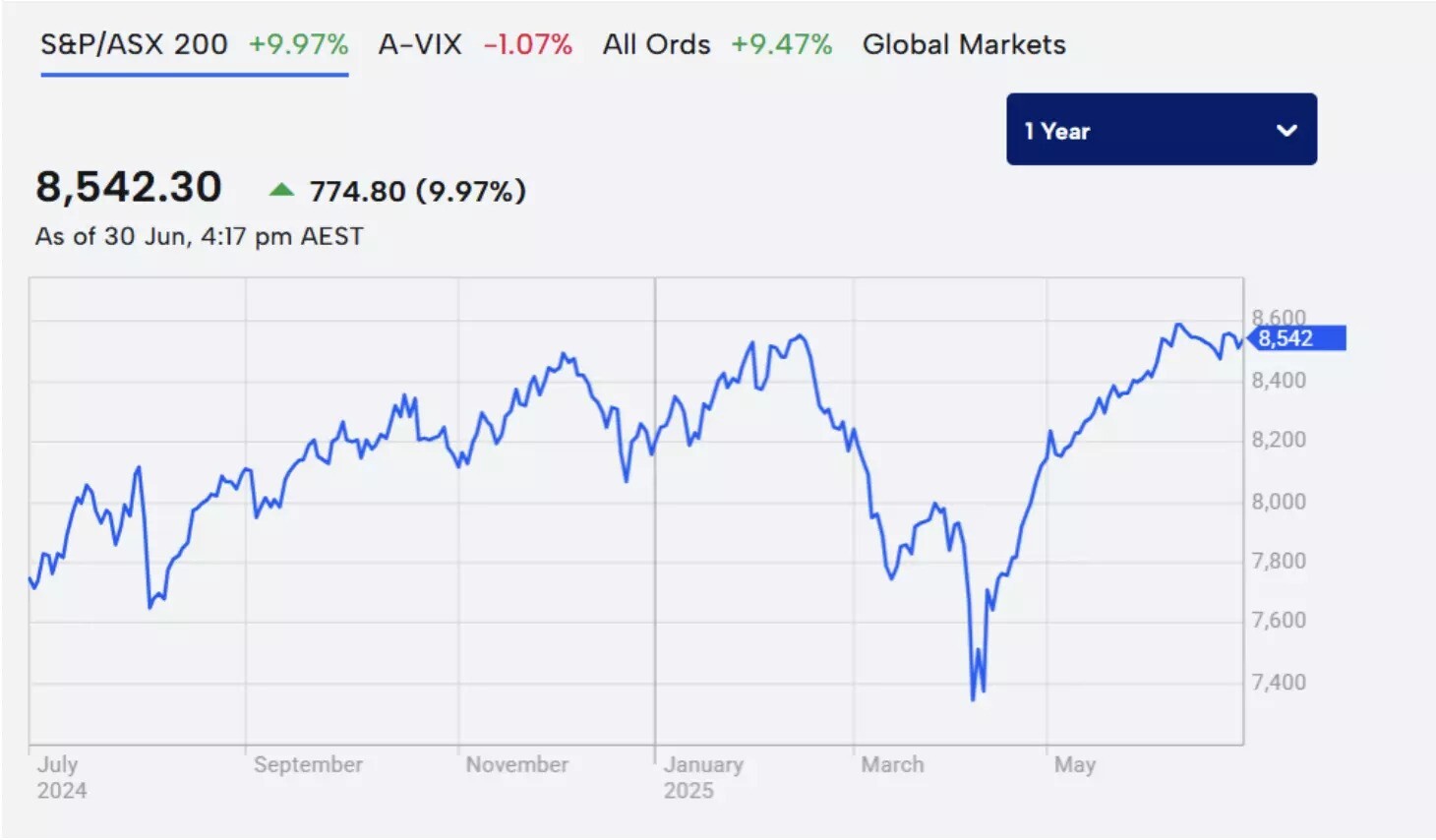
Sector Performance Rankings
Financials
The ASX 200 financials sector was the top-performing market sector of FY25, with the Financials Index rising by 24.45% and delivering total returns including dividends of 29.39%.Sector Champion: Despite Commonwealth Bank's headline-grabbing 45% rise that captured most investor attention, it was retirement and general investment solutions provider, Generation Development Group (ASX: GDG), that led the sector with a rise of 114% in FY25.
Technology - AI Boom Continues
The Information Technology Index rose by 23.89% and provided a total return of 24.19%.Sector Champion: TechnologyOne outperformed both its FY24 and 1H25 earnings expectations — 9.8% and 11.3% on each result respectively. ASX:TNE rose 121% during FY25 to close at $41.01.
Communications
The Communications Index gained 23.4% for the year.Sector Champion:EVT topped the communication leaderboard in FY25. The stock has largely traded nowhere since 2015, but found some momentum thanks to a bump in earnings from its cinema business, with the stock rising 41%.
Industrials
The Industrials Index gained 22% during FY25.Sector Champion: Qantas Airways (ASX:QAN) shares rose 84% to close at $10.74. Lower jet fuel prices, strong international and domestic pricing, and capacity growth gave investors renewed confidence in the leading Australian airline.
Consumer Discretionary
The Consumer Discretionary Index rose 18% for the year.Sector Champion: Temple & Webster Group (ASX:TPW) dominated the sector with a 127% gain to $21.32. Improved consumer sentiment and strong sales saw the e-commerce furniture company capitalise on momentum, especially in its home improvement and B2B categories.
Real Estate & REITs
The Real Estate Index gained 10% despite volatile bond yields throughout the year.Sector Champion: Charter Hall Group (ASX:CHC) was the sector leader — closing the financial year 72% higher at $19.19 per share.[caption id="attachment_712086" align="alignnone" width="1101"]
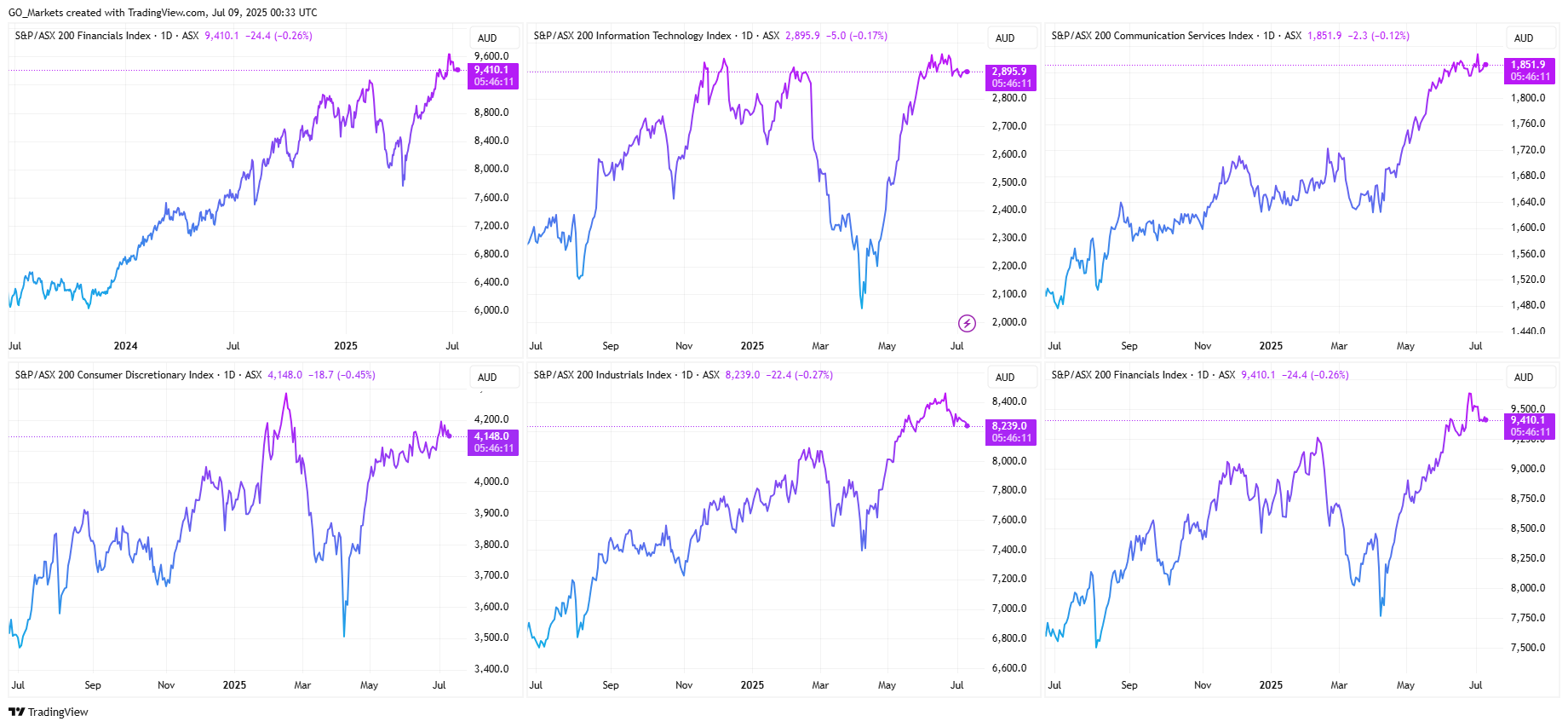
Top-performing sectors in FY25[/caption]
Utilities
The Utilities Index fell 1.6%.Sector Champion: APA Group (ASX:APA) managed a modest 2.3% gain in FY25, but managed to come out above its peers as the sector's best performer.
Consumer Staples
The Consumer Staples Index declined 2.1%.Sector Champion: Bega Cheese (ASX:BGA) led the sector with a 28% gain, backing up its strong FY24 results.
Healthcare
The Healthcare Index fell 5.99% despite some individual standouts.Sector Champion: Sigma Healthcare's merger with Chemist Warehouse created one of the biggest rallies of the year. As the merger gained clarity, the stock's potential inclusion in the S&P/ASX 200 drove strong buying from investors. Sigma (ASX:SIG) gained 135% to close at $2.99.
Materials
The second-worst sector was materials, with the Materials Index dropping 6.04%. Sector Champion: Despite sector struggles, gold miner Regis Resources (ASX:RRL) ascended 150% to close at $4.39, benefiting from rising gold prices.
Energy - The Year's Biggest Loser
The worst-performing ASX sector was energy, with the Energy Index falling 13.52%. Influences largely by the sector's largest stock — Woodside Energy Group — crumbling by 16%, closing at $23.66. Sector Champion: Uranium explorer Deep Yellow (ASX:DYL) stood out in the struggling sector with a 25% gain.[caption id="attachment_712087" align="alignleft" width="1051"]
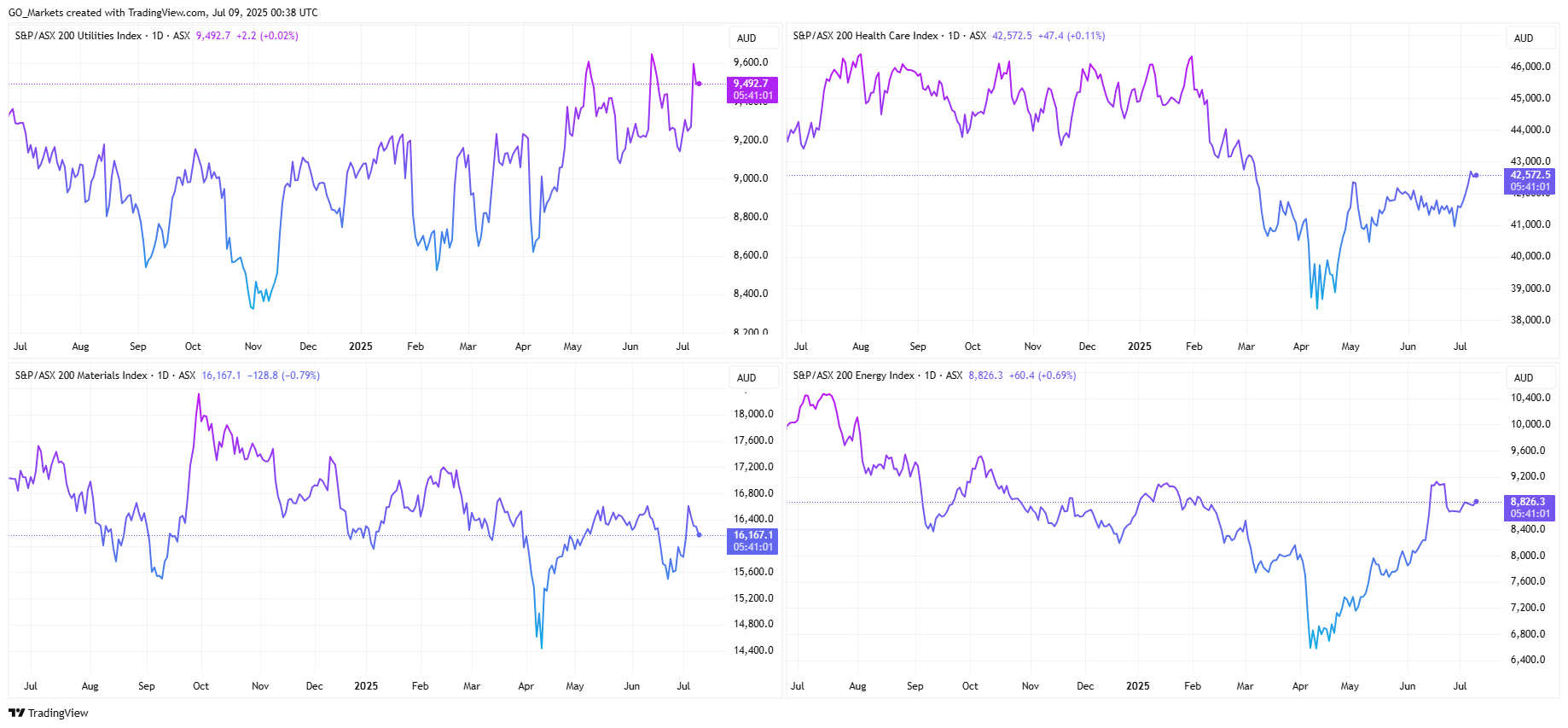
Worst-performing sectors in FY25[/caption]
Looking Ahead
The results of FY25 tell a simple story: execution matters more than sector. Technology and financials thrived because the best companies in these sectors did what they said they would do. Energy and materials struggled because many companies in these sectors are fighting structural headwinds, not just cyclical ones. The market is becoming more about which companies to back, rather than which sectors to back. Looking forward to FY26, this pattern could become even more pronounced as geopolitical tensions and trade wars see market uncertainty become the norm rather than the exception.


在海啸来临之前,最前端的波浪往往会形成一个低压波,导致海水被向外拉走,呈现出短暂的退潮现象。此时,海面看似风平浪静、海浪减弱,实则是一场巨大浪潮的前奏,正在暗中积蓄力量。TradingView上有一个技术指标正是基于这种原理设计的。它由知名交易员John Carter创造,旨在识别波动率收缩之后的爆发性行情,通过结合布林带与Keltner通道的特性,精准捕捉趋势启动前的蓄势阶段。这个指标被命名为 挤压动量指标(Squeeze Momentum Indicator),并已成为 TradingView 上点赞数最多的技术指标。

接下来,我们将深入解析这个指标的核心逻辑、实际用途与典型应用场景。挤压动量指标的核心逻辑是通过对布林带和Keltner通道的相对位置进行判断,从而识别市场是否处于波动率压缩状态。当布林带的上下轨收窄,并且整体位于Keltner通道的上下轨之内时,表明市场波动性极低,处于所谓的挤压状态。在这种情况下,多空双方处于短暂均衡,但价格随时可能因资金推动或消息驱动而突破平衡区间,引发强趋势行情。当布林带重新张开,并突破Keltner通道的边界时,说明挤压解除,市场进入动量释放阶段。这一压缩到爆发的过程,正是挤压动量指标用来捕捉关键入场时机的核心逻辑。
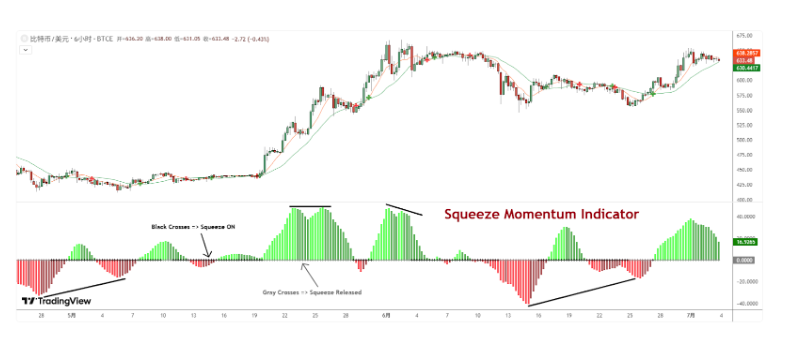
布林带的计算方法基于统计标准差。其中心线为一定周期(通常为 20)的简单移动平均线(SMA),上下轨分别为该均线加减两倍标准差。具体计算为:中轨 = SMA(20),上轨 = SMA(20) + 2 × 标准差,下轨 = SMA(20) − 2 × 标准差。标准差反映的是价格在一定时间窗口内的波动程度,因此布林带在市场波动增强时会变宽,波动减弱时收窄。相比之下,Keltner 通道的构建是基于平均真实波幅(ATR),更注重价格的实际波动范围。其中心线通常是 20 日的指数移动平均线(EMA),上下轨分别为该均线加减 1.5 倍的 ATR。计算方式为:中轨 = EMA(20),上轨 = EMA(20) + 1.5 × ATR(20),下轨 = EMA(20) − 1.5 × ATR(20)。ATR 的计算以“真实波幅”(True Range, TR)为基础。具体来说,单日的 TR 是以下三者中的最大值:当日最高价减去最低价、当日最高价与前一日收盘价的差值(取绝对值)、以及当日最低价与前一日收盘价的差值(同样取绝对值)。这种计算方式不仅考虑了当日的价格波动,也将跳空缺口带来的剧烈波动纳入衡量范围。将过去若干周期(例如 20 日)的 TR 进行移动平均,便得到了 ATR 值。挤压动量指标的判定条件就是比较这两个通道的位置关系:当布林带的上轨低于 Keltner 上轨,且布林带下轨高于 Keltner 下轨时,即为“挤压开启”,意味着市场波动率达到低点;而当布林带的任何一条轨道重新突破 Keltner 通道的边界时,则被视为“挤压解除”。此外,该指标还会通过柱状图显示动量方向与强度,绿色代表上涨动能增强,红色则表示下跌动能增强,柱子的高度反映动能大小。尽管挤压动量指标因其独特的波动率收缩与动量判断逻辑在TradingView上收获了大量点赞和认可,但它并非万能。挤压动量指标在周期性较为明确、趋势延续性强的品种上表现出较高的准确率,例如一些主流货币对、指数或大宗商品。这些市场的波动节奏相对稳定,趋势启动和结束的信号更加清晰,使得通过波动率压缩捕捉突破的思路更加有效。然而,在那些价格经常出现快速反转、震荡频繁且缺乏明显趋势的品种上,挤压动量指标的准确率则相对较低。由于市场行情反复无常,挤压状态往往被多次反复触发,导致信号出现较多假突破,交易者可能会面临更多噪音和误判的风险。因此,单纯依赖该指标进行买卖决策时,需要结合其他工具或技术面进行辅助确认,以避免被频繁的波动干扰。事实上,TradingView社区中对挤压动量指标的大量点赞更多的是对其背后核心思想的认可。很多交易者欣赏它通过量化波动率变化,揭示潜在巨大波幅行情的思路,这种基于统计学和市场行为结合的计算方法满足了每个投资者对何时行情会爆发的根本关注。正是这份理念,让挤压动量指标成为了众多技术指标中极具启发性和实用价值的一员,值得交易者深入理解和灵活应用,而非盲目追求完美信号。联系方式:墨尔本 03 8658 0603悉尼 02 9188 0418中国地区(中文) 400 120 8537中国地区(英文) +248 4 671 903作者:Michael Miao | GO Markets 悉尼中文部


The ASX 200 closed out the 2025 financial year on a high, reaching a new intra-month peak of 8,592 in June and within touching distance of the all-time record. The index delivered a 1.4% total return for the month, rounding off a strong final quarter with a 9.5% return and locking in a full-year gain of 13.8% — its best performance since 2021.This strong finish all came down to the postponement of the Liberation Day tariffs. From the April 7 lows through to the end of the financial year, the ASX followed the rest of the world. Mid-cap stocks were the standout performers, beating both large and small caps as investors sought growth opportunities away from the extremes of the market. Among the sectors, Industrials outperformed Resources, benefiting from more stable earnings and supportive macroeconomic trends tied to infrastructure and logistics.But the clear winner was Financials, which contributed an incredible 921 basis points to the overall index return. CBA was clearly the leader here, dominating everything with 457 basis points on its own. Westpac, NAB, and others also played a role, but nothing even remotely close to CBA. The Industrials and Consumer Discretionary sectors made meaningful contributions, adding 176 and 153 basis points, respectively. While Materials, Healthcare, and Energy all lagged, each detracting around 45 to 49 basis points. Looking at the final quarter of the financial year, Financials were by far the biggest player again, adding 524 basis points — more than half the quarter’s total return of 9.5%. Apart from a slight drag from the Materials sector, all other parts of the market made positive contributions. Real Estate, Technology, and Consumer Discretionary followed behind as key drivers. Once again, CBA was the largest individual contributor, adding 243 basis points in the quarter, while NAB, WBC, and Macquarie Group added a combined 384 basis points. On the other side of the ledger, key underperformers included BHP, CSL, Rio Tinto, Treasury Wine Estates, and IDP Education, which all weighed on quarterly performance.One of the most defining features of the 2025 financial year was the dominance of price momentum as a market driver — something we as traders must be aware of. Momentum strategies far outpaced more traditional, fundamental-based approaches such as Growth, Value, and Quality. The most effective signal was a nine-month momentum measure (less the most recent month), which delivered a 31.2% long-short return. The more commonly used 12-month price momentum factor was also highly effective, returning 23.6%. By contrast, short-term reversals buying last month’s losers and selling last month’s winners was the worst-performing approach, with a negative 16.4% return. Compared to the rest of the world, the Australian market was one of the strongest trades for momentum globally, well ahead of both the US and Europe, despite its relatively slow overall performance.Note: these strategies are prone to reversal, and in the early days of the new financial year, there has been a notable shift away from momentum-based trading to other areas. Now is probably too early to say whether this marks a sustained change, but it cannot be ignored, and caution is always advised.The second big story of FY26 will be CBA. CBA’s growing influence was a key story of FY25. Its weight in the index rose by an average of 2.1 percentage points across the year, reaching an average of 11.5% by June. That helped push the spread between the Financials and Resources sectors to 15.8 percentage points — the widest gap since 2018. Despite the strong cash returns, market valuations are eye-watering; at one point during June, CBA became the world’s most expensive bank on price metrics. The forward price-to-earnings multiple now sits at 18.9 times. This is well above the long-term average of 14.7 and higher than the 10-year benchmark of 16.1. Meanwhile, the dividend yield has slipped to 3.4%, down from the historical average of 4.4%. Earnings momentum remains soft, with FY25 growth estimates still tracking at 1.4%, and FY26 forecast at a moderate 5.4%. This suggests that recent gains have come more from expanding valuation multiples than from actual earnings upgrades, making the August reporting date a catalyst day for it and, by its size, the market as a whole.On the macro front, attention now turns to the Reserve Bank of Australia. The central bank cut the cash rate by 25 basis points to 3.6% at its July meeting. Recent commentary from the RBA has taken on a more dovish tone, with benign inflation data and ongoing global uncertainty expected to outweigh the strength of the labour market. The RBA appears to be steering toward a neutral policy stance, and markets will be watching for further signals on how that shift will be managed. Recent economic data has been mixed. May retail sales were weaker than expected, while broader household spending indicators held up slightly better. Building approvals saw a smaller-than-hoped-for bounce, employment remains strong, but productivity is low. Inflation is now at a 3-year low and falling; all this points to underlying support from the RBA’s easing bias both now and into the first half of FY26.As we move into FY26, the key questions are:
- Can fundamentals wrestle back control over momentum?
- Will earnings growth catch up to price to justify valuations?
- How will policy decisions from the RBA and other central banks shape investor sentiment in an ever-volatile world?
While the early signs suggest a possible rotation, the jury is still out on whether this marks a new phase for the Australian market or just a brief pause in the rally that defined FY25.

